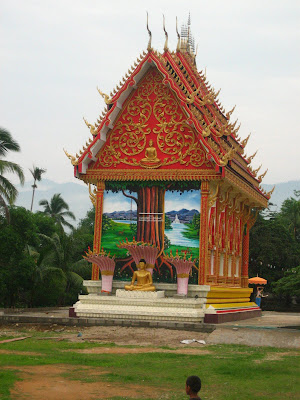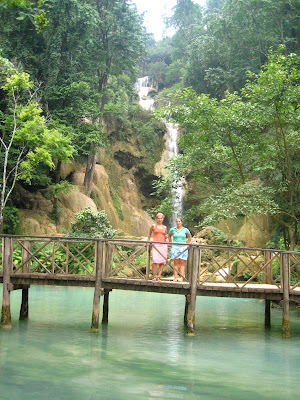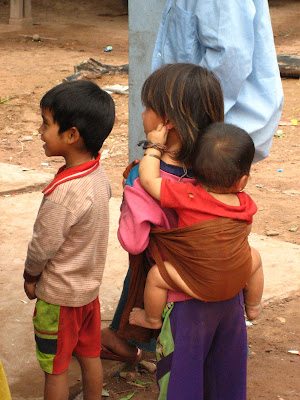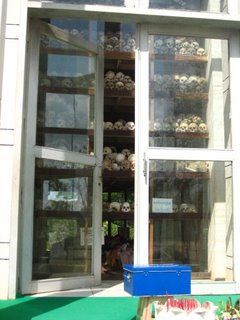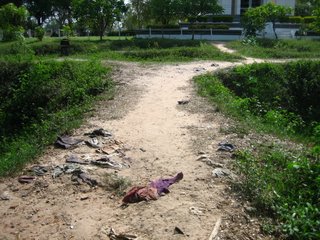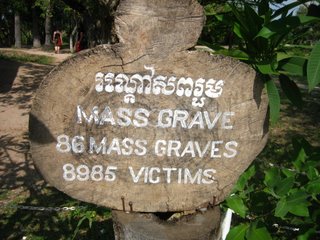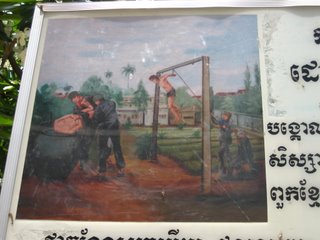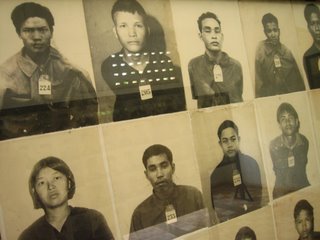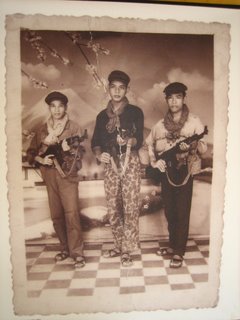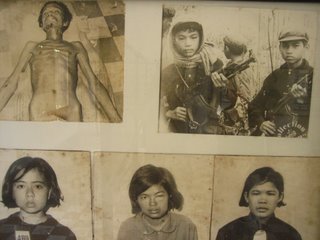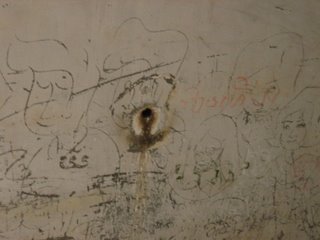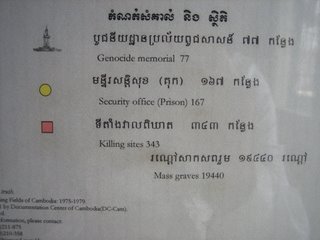Laos Techno Volume 3. Tragic bus journey entertainment
Before my whole visa/life passed by in heavenly Luang Prabang city, I had to get back on the road. Until now, my journeys in Laos had been in the relative luxury of hired minibuses with suspension, friends, and drivers racing to get home before nightfall. Now I was going to cover ¾ of the country on the public buses.
The 6 hour ride to Nong Khiaw was by sawngthaew (“song tao”) meaning 2 rows: a flat-back truck with 2 benches facing each other along the sides. My travel companions included a boy holding a rooster round the throat to keep it calm, women with unliftable sacks of fresh vegetables, and a bag full of chopped animal chunks in ice (that rapidly melted and sourced a stream of leaked diluted blood that meandered and surged towards different peoples’ sandals with the weaving of the road). Under someone’s bit of bench was a box of chicks chirping, more frantically so after going airborne over pot-holes then thudding back down. We were told to twist our torsos diagonally, as shoulder-against-shoulder limited space for only 18 passengers, and there were always ethnic minority grannies and snotty urchins and their sacks waving by the road to be rammed in, on, under, over us. Now proverbial sardines, another stop and another family and their market stall of produce was somehow wedged in between our elbows and feet, on the roof, in pockets, and probably behind the box of chicks.

Fellow passengers
On the roof were wooden armchairs, amongst other things. You can take anything on Lao public transport and people do. I saw one sawngthaew loaded to axle-buckling with 3 huge water buffalo, another with motorbikes on the back. Is the idea of piling a whole town onto a pick-up truck to re-enact The Grapes of Wrath? So far, fascinating.

Boarding the bus

Before picking up passengers

The luxury intercity bus
The next day I discovered how to get even more thrill from the sawngthaew ride: to sit almost hanging off the very back. You don’t get buried under sacks of papayas, snozzcumbers (did the BFG live in Laos?) and pig innards, and you’re literally in, rather than watching, the scenery: jungle mountainsides and rickety hut villages flanking this deserted and only paved road from central Laos to China. We chugged past pre-teen kids lugging great baskets of logs on their backs, some weight transferred from back to neck by a strap round their foreheads, forest-slashing machetes in hand. Mothers in their thirties are worn and wrinkled to double that age by 10 mile a day hikes for water and firewood through sun, sweat, toil, and having suckled 4 offspring and a couple more who didn’t survive their early years. Primary rainforest smothered by creeping vegetation grows right down to the roadside where it hasn’t been slashed and burned to soily mountain slope and charred logs. The price of progress.


Typical roadside scenes
At Odomxai Chinese trading town I was relegated into the worst interior-designed bus ever. Metal lumps and sharp ridges, screws, bolts and handles projected from windowsills and seats, right where elbows and legs naturally fall to rest. On every hairpin, my kneecap would swing sideways and thwack into a steel knob or chunk of tough plastic projecting outfrom the back of the seat 20cm infront, there solely to end foreigners’ pub-league football careers. The bus designer evidently never took into account human sized passengers or the bus being hurled round corners at speeds Asian drivers put the Schumachers to shame with. It was like being wedged into an oil drum with the contents of a mechanic’s toolbox then rolled down Kilimanjaro. Millionaire wannabes take note! Design a bus for passengers taller than 5 foot 5 to be built in Asia, and you’ll be sharing canapés with Bill Gates in no time.
Despite my grumbling, I was lucky to have a ‘proper’ seat, rather than one of the nursery school pink chairs with buckling legs that were lined down the aisle, that a big Aussie was thrown onto the hot gearbox cover from at every left-hand bend. And I didn’t have to hand over my papers for intense scrutiny at checkpoints as the locals did.

Women in the aisle seats
So far still alright, though grumpiness inducing after 8 hour stints. But on doing a U-turn after visiting the far north, so did my luck.
For the length of the country southwards (60 hours), the bus journeys were from The Pit. I’d barely survived them across Cambodia and Indonesia, and was close to weeping at again being punished for untold sins in this manner. What makes me judder as I write this isn’t the poor road quality, manic driving, each square metre of interior and roof taken up by 10 human, avian, and dissected porcine bodies, or even the male choir of hoikers and spitters that leave the bus aisle glistening with little lime green parcels for tourists to slip on. Oh no, it’s much worse: the music and the puking.
The music on that first 14 hour journey south had broken me in Indonesia. Thankfully the driver didn’t like it either, and demanded his teeny DJ boy (there purely to eject the scratched music DVD then instantly reinsert it, 30 times a journey) turn it off. Phew! But within 5 minutes he was bored and ordered it back on. Gutted! Then after 3 songs back off. Then on again. Then off again. Then just one track on repeat. Why 12 hours of this? Because he has a Southeast Asian male brain. There’s no other explanation and none is needed. By midnight I was rabid with rage. Either leave the din on and piss me off, or leave it off and let me relax as much as your kamikaze driving allows. But why get my hopes up on dozing to the relatively soothing tones of an over-revved diesel engine then shatter them every 5 minutes? I had to smile at the irony of having Faithless’s ‘Insomniac’ going round my head during the brief respites from Siam house music.
So what is it about the bus music of Laos and Cambodia that has me twitching with an aural equivalent of Gulf War Syndrome even now? I’ve identified the main elements of that music that, hand on heart, drove me to plot murder.
1. The singer is the same camp Thai bloke on every DVD. He sounds like Roy Chubby Brown with a chandelier-shattering falsetto and a peg on his nose, speed reading a Marvel comic into a kiddies Fisher Price music synthesiser (£4.99 in Woolworth’s).
2. The tempo is set by a cow bell struck twice a second, dinkdink dinkdink dinkdink dinkdink dinkdink dinkdink dinkdink dinkdink dinkdink dinkdink dinkdink dinkdink dinkdink dinkdink dinkdink dinkdink dinkdink dinkdink dinkdink dinkdink dinkdink in every song, never letting you relax. How would you feel stuck in a phonebox for a full day with an attention deficit disorder kid on Ecstacy, his frying pan and metal spoon?
3. The volume is so loud that the loudspeaker casing resonates, giving a tin can effect to the din. I might as well have stuffed my, “Quieten by 29 decibels” earplugs up my nostrils for all the effect they had.
4. The mentality of the driver who on an energy-draining, scorching, 15-hour, twisty-turny journey on steep mountainsides with a bus full of geriatric and child vomiters, and tourists desperate to read (why do the southeast Asians never read on buses?) or sleep, thinks booming Thai techno will soothe people’s stomachs/nerves/tempers?
Another glance at the clock and it’s now 1am.
5. The fact that none of the locals seem affected or even aware of this racket leads me to feel it’s a team conspiracy just to see if they can make the foreigner pop with rage.
6. The videos (this is karaoke after all) accompanying the music are dire, well the lead males anyway. An absolute insult to the Y chromosome! There are three roles:
A. A full-blown drag and drama queen;
B. A pre-surgery ladyboy wannabe: a mega-camp Ant or Dec eyebrow-flirting from a shiny, make-upped and skin-bleached face, like an Asian Orville and as bad a dancer;
C. An effeminate middle-aged bloke with his T-shirt tucked into his trousers and trying to be tough: think Eddie Izzard posturing and pouting and air punching like a gangsta rap ape.
On the on-stage gag concerts the men are either transvestites, unbelievably camp, or actually wail and tantrum in mimic of toddlers. They whine and whinge and cower and cry as much as speak, and act like adolescent apes in the presence of ladies. WHAT THE F**K IS THIS?! And why do the women tolerate it, on top of being full-time servants to their men?
To be fair to Laos, this is Thai ‘entertainment’. But there’s no excuse for buying this DVD, or subjecting me to it for 10 hours every day! Maybe it’s a government ploy to prevent uprisings by keeping the people numb. And if these are Laos’s, Camodia’s and Indonesia’s male role models, is it any wonder that the women are so interested in Western men. At least the teen Thai girl on the arm of the 60-year-old, pot-bellied and balding German sex-tourist gets some exposure to testosterone.

The karaoke disco bus to Savannakhet. Thankfully only a 10 hour journey today.
The 10 hour Phonsovan to Vientiane journey was one of the worst, the music capped by the pukers. After only 20 minutes and still crossing flat plains, the girl sat behind me and the woman opposite me were hurling and dribbling the contents of their stomachs into those transparent plastic bags you put your apples in in Tesco. The old woman only had one bag for comfort and didn’t want to be without it, so she clutched it shut as its watery yellow load bounced and swayed with the bus. She even fell asleep without letting go of it. The Asians have incredibly intolerant stomachs for journeying, yet could fall into a snoring coma on a speeding rollercoaster.
I got quite irritated by the lad infront who kept opening the window and chucking stuff out, along the grassy verge of one of the top 10 most stunning vistas in Asia. Couldn’t he have kept his bags, each with a banana skin in, until he could put it in his home litter bin? Then it dawned on me it wasn’t plastic-wrapped fruit skin he was chucking out. Hmmm.... probably best outside the bus, though biodegradable sick bags could be a niche market product.

Why would anyone want to throw their vomit on this scenery?
By the fourth 7pm I was soooo relieved to be back in the capital, unfairly labelled as, “Ah Vientiane, the Croydon of SE Asia” on my hostel room graffiti. I only had 16 more hours bus travel left to the Vietnam border. But first I needed a few days in Vientiane to recuperate.
So if anyone’s contemplating travelling Laos or Cambodia by bus, the most important consideration is a well-located seat. It’s a real task to get one, and requires careful planning and quick thinking. Not because of a scrum of Lao people charging on; they just stand in the aisle waiting to be yelled at by the driver where to sit. But because you have only 3 seconds to assess where is a balanced distance between front karaoke screen and rear seats near the engine (it’s +35oC before the engine is switched on, although the screaming engine does drown the music a little). Seats over the back wheel arches offer zero leg space: no good as you’re going to get boxes and sacks and kids and squawking/bckaaawing/snuffling farmyard animals dumped on your lap. Front end sit the puking grannies, at the back the puking, spitting, wailing, drunk men. A window lodged open is bad, despite the cooling breeze, as a puker’s load jettisoned out the bus from somewhere aft will re-enter in your face. But above all this, the urgency of your speedy scanning is for the locations of the overhead music speakers. Getting 2 rows and 10 decibels away from them makes all the vomiting trivial.
A week in the capital next…


























